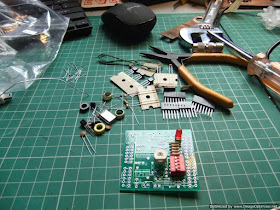Well,
My 30M QRSS Arduino based beacon is still on the air; and I am receiving reports via e-mail from time to time. The most recent was from Andre, DL8WX; he is in JO30WE 716.75 km (445.390 miles), bearing 112.3 degrees from me and said "I found ur beacon last night with a strong signal on 10140.02 kHz for the first time!". The beacon project build is here:
http://g0mgx.blogspot.co.uk/2013/06/qrssing-again.html
Last night, I left my FT-DX-3000 WSPRing on 40M using the dipole I made here:
http://g0mgx.blogspot.co.uk/2013/04/well-further-to-my-musings-last-time.html
and here's the result:
Before I left it alone I measured the power out exactly using my Arduino based power meter from here:
http://g0mgx.blogspot.co.uk/2012/11/the-power-is-with-me.html
and the list of stations heard/hearing looks like this:
So, you have to wonder, if this is achievable with 40dbM (10dBW or 10 watts), what could we achieve with far less power?
Given that the most recent 50mW QRSS beacon project is Arduino based, I could write some software to generate WSPR using that, I would need a GPS to give me an accurate time source, there's also exactly that in a (not quite finished) project from here:
http://g0mgx.blogspot.co.uk/2012/05/more-wspring-and-qrssing.html
or even this Hans Summers project from here will do it exactly as I describe above (GPS and WSPR):
http://g0mgx.blogspot.co.uk/2012/07/qrssing-again.html
So, time to fiddle!
As a slight aside, I'm going to Malta for a week soon and I have 9H3JM for use there; as my FT-450 is in Doha I have bought myself an FT-817 to take with me. This radio is capable of outputting much lower power levels than the other radios I have here, so perhaps the easiest option for some really low power WSPR is to use that?
Lets see.
My 30M QRSS Arduino based beacon is still on the air; and I am receiving reports via e-mail from time to time. The most recent was from Andre, DL8WX; he is in JO30WE 716.75 km (445.390 miles), bearing 112.3 degrees from me and said "I found ur beacon last night with a strong signal on 10140.02 kHz for the first time!". The beacon project build is here:
http://g0mgx.blogspot.co.uk/2013/06/qrssing-again.html
Last night, I left my FT-DX-3000 WSPRing on 40M using the dipole I made here:
http://g0mgx.blogspot.co.uk/2013/04/well-further-to-my-musings-last-time.html
and here's the result:
Before I left it alone I measured the power out exactly using my Arduino based power meter from here:
http://g0mgx.blogspot.co.uk/2012/11/the-power-is-with-me.html
and the list of stations heard/hearing looks like this:
So, you have to wonder, if this is achievable with 40dbM (10dBW or 10 watts), what could we achieve with far less power?
Given that the most recent 50mW QRSS beacon project is Arduino based, I could write some software to generate WSPR using that, I would need a GPS to give me an accurate time source, there's also exactly that in a (not quite finished) project from here:
http://g0mgx.blogspot.co.uk/2012/05/more-wspring-and-qrssing.html
or even this Hans Summers project from here will do it exactly as I describe above (GPS and WSPR):
http://g0mgx.blogspot.co.uk/2012/07/qrssing-again.html
So, time to fiddle!
As a slight aside, I'm going to Malta for a week soon and I have 9H3JM for use there; as my FT-450 is in Doha I have bought myself an FT-817 to take with me. This radio is capable of outputting much lower power levels than the other radios I have here, so perhaps the easiest option for some really low power WSPR is to use that?
Lets see.




























